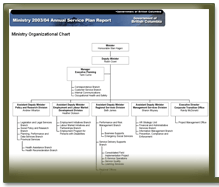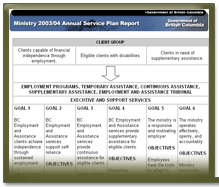 |
|
Ministry Role and ServicesMinistry OverviewThis overview identifies the principles that guided the ministry to provide services and programs during the fiscal year 2003/04 and it confirms the vision, mission, and values that were reflected in the ministry's service delivery as set out in the 2003/04 – 2005/06 Service Plan. The Ministry of Human Resources continued to support British Columbians in their efforts to be self-reliant by assisting them to move from income assistance to sustainable employment, and by providing income assistance to those most in need. The ministry was guided by two primary pieces of legislation, the Employment and Assistance Act and the Employment and Assistance for Persons with Disabilities Act. Through these two Acts the ministry continued to address the generational dependency cycle, improving the prospects of children by supporting the efforts of their parents to find and sustain employment and ending the on again, off again pattern that many income assistance clients have experienced. The ministry provided programs to assist clients to find and maintain employment. Temporary assistance was available to eligible people who were capable of financial independence through employment, and ongoing assistance was available to those who were not expected to gain independence through employment. The ministry provided supplementary assistance to clients with disabilities, persons with persistent multiple barriers to employment, children, seniors and clients requiring medical, dental or transportation services. The ministry worked closely with the Provincial Emergency Program (PEP) to ensure that Emergency Social Services (ESS) were available to families and communities in crisis. A key element of the BC Employment and Assistance program (BCEA) continued to be the ability of clients to access services that assist them toward employment. For some, support and assistance in undertaking a work search was all that was needed. Others who sought assistance needed more extensive employment supports. For persons with disabilities or with barriers to employment income assistance provided other kinds of services and supports. Applicants were required to complete a three-week self-directed work search before applying for income assistance. All people who contacted a ministry office could be assessed for emergency needs, such as an urgent need for food, shelter, or medical attention, and those who had an emergency need received an expedited application for income assistance. The ministry maintained the principle that employment encourages self-reliance and reduces dependence on income assistance. It helps break the cycle of dependency that can begin the first time a client receives income assistance. BCEA actively encourages self-reliance through employment, an approach that benefits families and individuals over the long-term. The ministry provided services to the following client groups: clients who received temporary assistance, clients with persistent multiple barriers to employment, persons with disabilities and people in need of supplementary assistance. Clients who were able to work were assisted to find jobs through employment plans. Employment plans outlined the actions clients were required to take in seeking work. They provided access to the tools and supports clients needed to find a job and become independent of income assistance.
Ministry Vision, Mission and ValuesVisionThe Ministry of Human Resources envisions a province in which those British Columbians in need are assisted to achieve their social and economic potential. MissionThe Ministry of Human Resources provides services that move people toward sustainable employment and assists individuals and families in need. ValuesThe Ministry of Human Resources' values are reflected in its work every day, and support the government's broader strategic plan and priorities. The government's core values are integrity, fiscal responsibility, accountability, respect and choice. The ministry's values are:
Ministry Operating ContextThe British Columbia economy grew 2.2 per cent in 2003, tied for fourth among provinces with Alberta, after growth of 2.4 per cent in 2002. Domestic activity was the main driver of economic growth last year. Consumer spending, which accounts for about two-thirds of all economic activity in the province, benefited from continued low interest rates and robust employment growth. In 2003, housing starts recorded significant growth of 21 per cent and the British Columbia economy posted average annual job growth of 2.5 per cent. Overall, growth in business investment accelerated to 8.2 per cent, mainly reflecting strength in the residential construction sector. The Canadian dollar appreciated rapidly in 2003 and the higher value of the currency had a significant impact on the trade sector. As a result, export growth was limited to 0.5 per cent growth in 2003, while imports grew a stronger 4.3 per cent. External FactorsA number of factors external to the ministry contributed to the decline in the income assistance caseload during 2003/04:
Two significant external trends are potential contributors to an increased demand for income assistance in the future:
Internal FactorsA number of internal factors contributed to the ministry's ability to achieve its goals and objectives for 2003/04:
Ministry Structure and Core Business AreasDuring 2003/04, the ministry was organized under four divisions: Policy and Research Division, Employment and Labour Market Development Division, Regional Services Division, and Management Services Division. Frontline services were delivered to clients through 112 offices located in the ministry's five regions. In addition, contracted services such as job readiness and employment training programs were provided across the province by agencies funded by the ministry.
The ministry's major services were provided under the BC Employment and Assistance program (BCEA), that emphasized self-reliance and personal responsibility, and was designed to reduce long-term dependence on income assistance by those able to work. For clients unable to work because of a disability, BCEA offered income assistance and an array of programs to assist in enhancing involvement in their communities. The ministry also provided supplementary services such as bus passes and emergency social services to meet pressing needs. During 2003/04, the ministry delivered its programs and services through six core business areas, each of which was directly tied to the ministry's vision, mission and goals. Core Business: Employment ProgramsEmployment programs were available to assist clients to find and sustain employment. Individualized employment plans that were signed by clients could include directed job search, referral to job placement programs and specific training for employment. Specialized programs that support persons with disabilities were included within this core business area. Core Business: Temporary AssistanceTemporary assistance was available to clients who were capable of financial independence through employment, or were unable to seek work because of a short-term condition, as described in the Employment and Assistance Act. Core Business: Continuous AssistanceContinuous assistance was available to eligible individuals who were not expected to gain complete financial independence through employment, including clients with disabilities and those with multiple barriers to employment. Core Business: Supplementary AssistanceSupplementary assistance was available to eligible people, providing health and other supports such as emergency shelters, bus passes, health services for persons with disabilities, and user fees for continuing care and alcohol and drug treatment facilities. Core Business: Employment and Assistance Appeal TribunalThe Employment and Assistance Appeal Tribunal was created in September 2002 to assist clients with timely decision-making through a single-level, regionally based appeal system that was available for individuals who wished to appeal decisions of the ministry. The tribunal operates independently of the ministry. Core Business: Executive and Support ServicesExecutive and support services provided salaries, benefits, allowances and operating expenses for the minister's office, ministry corporate services and service delivery.
Update on New Era CommitmentsIn a June 25, 2001 letter to the Minister of Human Resources, Premier Gordon Campbell identified three key priorities for the ministry to focus on in its first three years: 1. Continue to streamline regional service delivery to clients of income assistance. 2. Implement training and support programs to assist income assistance clients in returning to the workforce. 3. With the Administrative Justice Project, develop a single internal appeal process. 1. Streamlining regional service delivery. On September 30, 2003, the Ministry of Human Resources moved its regional structure from nine regions to five. New regional boundaries matched those of our partner ministries — Ministry of Children and Family Development and Ministry of Health Services. As a result, ministries had common work assignment areas and were able to work better together, providing more streamlined and coordinated services. The ministry continued to develop longer-term Electronic Service Delivery (ESD) initiatives, such as expanding the client call centre. This enables staff, over time, to spend more time serving clients, improve public access to ministry information and improve the ministry's capacity to meet its goals. To assist in meeting current and future service plan requirements in a rapidly changing environment, the ministry began exploring ways to adapt business processes to meet future challenges. The Process Improvement Project was established to review and redesign employment planning and the financial eligibility processes. Specifically, the Process Improvement Project was implemented to:
2. Implementing training and support programs to assist income assistance clients in returning to the workforce. The Job Placement Program continued and was refined in 2003/04 to support clients in their move to independence. In partnership with contracted agencies, the program provided a range of services that included assessing clients' job-readiness, supporting clients to find employment, monitoring clients' progress in the workplace and providing support to employers. The Training for Jobs Program was implemented in December 2002. The program continued in 2003/04 to provide short-term, integrated training to enable clients — especially those who face barriers to employment, and those who have not found employment with the assistance of other ministry programs — to enter or return to sustainable employment as quickly as possible. Contracted service providers worked with clients to identify their training needs, provide skill-specific training, place clients in employment and support them to sustain that employment over a period of 18 months. The Employment Program for Persons with Disabilities was fully implemented in September 2003. The program provided a range of specialized services to support persons with disabilities to take on employment or employment-related activities. The program included pre-employment, employment planning and employment services. It provided supports for persons with disabilities in the workplace. Clients who were not seeking independence through employment were supported to work part-time or participate in volunteer activities in their communities. The ministry also implemented the Bridging Employment Program, which assisted survivors of violence and abuse to move toward greater self-reliance, and the English as a Second Language Training for Jobs program that improved English and provided access to technical training. 3. Development of a streamlined appeal process. The Employment and Assistance Appeal Tribunal was introduced in September 2002. Developed in conjunction with the Administrative Justice Project, the Tribunal provided a single, streamlined, independent process for reviewing clients' appeals in an open, fair and timely way. It replaced the previous multi-step appeal process, under which appeals sometimes took as long as six months to be concluded. With this process, regional panels continued to adjudicate appeals within the legislated time frame of 15 business days.
|
||||||||||||||||||||||||||||||||||||||||||||||||||||||||||||||||||||||||
|
|||||||||||||||||||||||||||||||||||||||||||||||||||||||||||||||||||||||||


